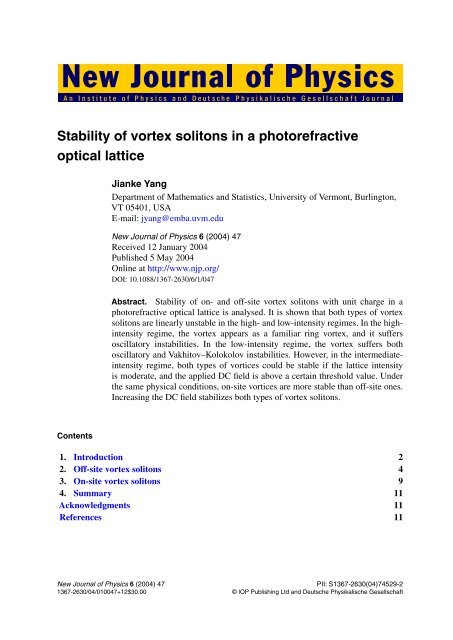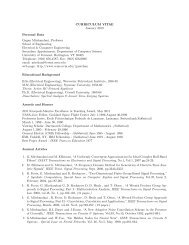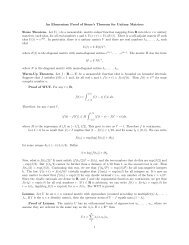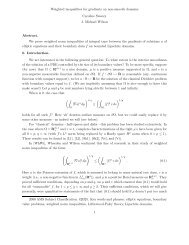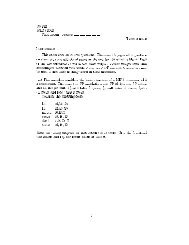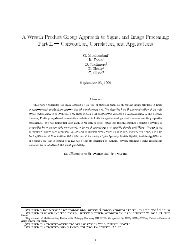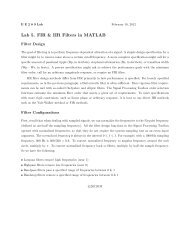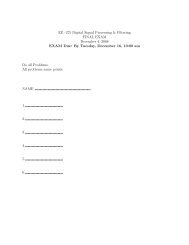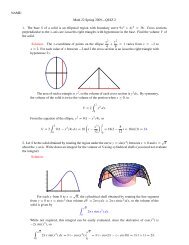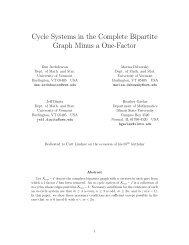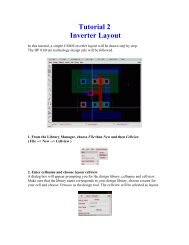Stability of vortex solitons in a photorefractive optical lattice
Stability of vortex solitons in a photorefractive optical lattice
Stability of vortex solitons in a photorefractive optical lattice
You also want an ePaper? Increase the reach of your titles
YUMPU automatically turns print PDFs into web optimized ePapers that Google loves.
<strong>Stability</strong> <strong>of</strong> <strong>vortex</strong> <strong>solitons</strong> <strong>in</strong> a <strong>photorefractive</strong><strong>optical</strong> <strong>lattice</strong>Jianke YangDepartment <strong>of</strong> Mathematics and Statistics, University <strong>of</strong> Vermont, Burl<strong>in</strong>gton,VT 05401, USAE-mail: jyang@emba.uvm.eduNew Journal <strong>of</strong> Physics 6 (2004) 47Received 12 January 2004Published 5 May 2004Onl<strong>in</strong>e at http://www.njp.org/DOI: 10.1088/1367-2630/6/1/047Abstract. <strong>Stability</strong> <strong>of</strong> on- and <strong>of</strong>f-site <strong>vortex</strong> <strong>solitons</strong> with unit charge <strong>in</strong> a<strong>photorefractive</strong> <strong>optical</strong> <strong>lattice</strong> is analysed. It is shown that both types <strong>of</strong> <strong>vortex</strong><strong>solitons</strong> are l<strong>in</strong>early unstable <strong>in</strong> the high- and low-<strong>in</strong>tensity regimes. In the high<strong>in</strong>tensityregime, the <strong>vortex</strong> appears as a familiar r<strong>in</strong>g <strong>vortex</strong>, and it suffersoscillatory <strong>in</strong>stabilities. In the low-<strong>in</strong>tensity regime, the <strong>vortex</strong> suffers bothoscillatory and Vakhitov–Kolokolov <strong>in</strong>stabilities. However, <strong>in</strong> the <strong>in</strong>termediate<strong>in</strong>tensityregime, both types <strong>of</strong> vortices could be stable if the <strong>lattice</strong> <strong>in</strong>tensityis moderate, and the applied DC field is above a certa<strong>in</strong> threshold value. Underthe same physical conditions, on-site vortices are more stable than <strong>of</strong>f-site ones.Increas<strong>in</strong>g the DC field stabilizes both types <strong>of</strong> <strong>vortex</strong> <strong>solitons</strong>.Contents1. Introduction 22. Off-site <strong>vortex</strong> <strong>solitons</strong> 43. On-site <strong>vortex</strong> <strong>solitons</strong> 94. Summary 11Acknowledgments 11References 11New Journal <strong>of</strong> Physics 6 (2004) 47PII: S1367-2630(04)74529-21367-2630/04/010047+12$30.00 © IOP Publish<strong>in</strong>g Ltd and Deutsche Physikalische Gesellschaft
2 DEUTSCHE PHYSIKALISCHE GESELLSCHAFT1. IntroductionVortex <strong>solitons</strong> are ubiquitous <strong>in</strong> many branches <strong>of</strong> physics such as optics [1] and Bose–E<strong>in</strong>ste<strong>in</strong>condensates [2]–[4]. In a homogeneous medium, bright <strong>vortex</strong> r<strong>in</strong>gs are unstable [5], and onlydark <strong>vortex</strong> <strong>solitons</strong> are possible with defocus<strong>in</strong>g non-l<strong>in</strong>earity [1, 6]. However, <strong>in</strong> the presence<strong>of</strong> a periodic <strong>optical</strong> <strong>lattice</strong>, stable <strong>lattice</strong> vortices become possible due to the guid<strong>in</strong>g properties<strong>of</strong> the <strong>lattice</strong>. Indeed, recent theoretical work [7, 8] has shown that <strong>in</strong> an <strong>optical</strong> <strong>lattice</strong> with Kerrnon-l<strong>in</strong>earity, both on-site vortices (vortices whose s<strong>in</strong>gularity is located on a <strong>lattice</strong> site) [7]and <strong>of</strong>f-site vortices (vortices whose s<strong>in</strong>gularity is located between sites) [8] are stable with<strong>in</strong>certa<strong>in</strong> ranges <strong>of</strong> parameters. These theoretical studies are quickly followed by experiments <strong>in</strong><strong>photorefractive</strong> crystals, where <strong>vortex</strong> <strong>lattice</strong> <strong>solitons</strong> have been observed very recently [9, 10].See [11, 12] for a review <strong>of</strong> other nonl<strong>in</strong>ear localized states <strong>in</strong> one- and two-dimensional (2D)periodic <strong>optical</strong> waveguides.<strong>Stability</strong> <strong>of</strong> <strong>vortex</strong> <strong>lattice</strong> <strong>solitons</strong> <strong>in</strong> <strong>photorefractive</strong> crystals is clearly an important issue.This question was considered <strong>in</strong> [10], where the evolution <strong>of</strong> a particular on-site <strong>lattice</strong> <strong>vortex</strong>under random-noise perturbations was simulated. It was found that the on-site <strong>vortex</strong> was stableto very long distances. However, we know that <strong>lattice</strong> vortices <strong>in</strong> <strong>photorefractive</strong> crystals cannotall be stable. For <strong>in</strong>stance, when the peak <strong>in</strong>tensity (or power) <strong>of</strong> the <strong>vortex</strong> is high, the <strong>lattice</strong> iseffectively weak, thus the <strong>lattice</strong> <strong>vortex</strong> would become the familiar r<strong>in</strong>g <strong>vortex</strong>, which is knownto be unstable (see figure 1(b)) [5]. The natural questions to ask then are: what <strong>lattice</strong> vorticesare stable? If <strong>lattice</strong> vortices are unstable, what are the sources <strong>of</strong> their <strong>in</strong>stability? So far, thesequestions have not been addressed comprehensively for either <strong>of</strong> the on-site and <strong>of</strong>f-site <strong>lattice</strong>vortices.In this paper, we numerically study both the on-site and <strong>of</strong>f-site <strong>vortex</strong> <strong>solitons</strong> with unitcharge and determ<strong>in</strong>e their stability properties <strong>in</strong> a 2D <strong>photorefractive</strong> <strong>optical</strong> <strong>lattice</strong>. We showthat these vortices are not only unstable <strong>in</strong> the high-<strong>in</strong>tensity regime, but also <strong>in</strong> the low-<strong>in</strong>tensityregime. However, they can become stable <strong>in</strong> the <strong>in</strong>termediate-<strong>in</strong>tensity regime if the <strong>lattice</strong><strong>in</strong>tensity is moderate and, <strong>in</strong> addition, the applied DC bias field is above a certa<strong>in</strong> thresholdvalue. Under the same physical conditions, on-site vortices are more stable than <strong>of</strong>f-site ones,ma<strong>in</strong>ly because on-site vortices have larger hump separations than <strong>of</strong>f-site ones. Increas<strong>in</strong>g theDC bias field strongly stabilizes both types <strong>of</strong> vortices.The mathematical model for light propagation <strong>in</strong> a <strong>photorefractive</strong> crystal has been knownfor some time [13]. Here we make the usual paraxial assumption, and the assumption that the<strong>photorefractive</strong> screen<strong>in</strong>g non-l<strong>in</strong>earity acts isotropically along the two transverse directions,both <strong>of</strong> which are justified <strong>in</strong> many experiments. If the probe beam is extraord<strong>in</strong>arily polarized,while the <strong>lattice</strong> is ord<strong>in</strong>arily polarized, then the probe beam does not affect the l<strong>in</strong>ear <strong>lattice</strong>. Inthis case, the govern<strong>in</strong>g equation for the probe beam is [13]iU z + 12k 1(U xx + U yy ) − 1 2 k 0n 3 e r 33E sc U = 0, (1)where U is the slowly vary<strong>in</strong>g amplitude <strong>of</strong> the probe beam, z the distance along the direction<strong>of</strong> the crystal, (x, y) are distances along the transverse directions, k 0 = 2π/λ 0 the wavenumber<strong>of</strong> the laser <strong>in</strong> the vacuum (λ 0 is the wavelength), n e the refractive <strong>in</strong>dex along the extraord<strong>in</strong>aryaxis, k 1 = k 0 n e , r 33 the electro-optic coefficient for the extraord<strong>in</strong>ary polarization, E sc is theNew Journal <strong>of</strong> Physics 6 (2004) 47 (http://www.njp.org/)
3 DEUTSCHE PHYSIKALISCHE GESELLSCHAFTspace-charge field,E sc =E 01+I l (x, y) + |U| 2 , (2)E 0 the applied DC field, and I l the field <strong>in</strong>tensity <strong>of</strong> the <strong>optical</strong> <strong>lattice</strong>. Here the <strong>in</strong>tensities <strong>of</strong>the probe beam and the <strong>lattice</strong> have been normalized with respect to the dark irradiance <strong>of</strong> thecrystal I d . The dark irradiance is the background illum<strong>in</strong>ation used <strong>in</strong> experiments to f<strong>in</strong>e-tunethe non-l<strong>in</strong>earity. Material damp<strong>in</strong>g <strong>of</strong> the probe beam is very weak <strong>in</strong> typical experiments s<strong>in</strong>cethe crystals are fairly short (up to 2 cm), hence neglected <strong>in</strong> equation (1). If the <strong>lattice</strong> is periodicalong the x and y directions (rectangular <strong>lattice</strong>), then I l can be expressed asI l (x, y) = I 0 s<strong>in</strong> 2 π D x π s<strong>in</strong>2 y, (3)Dwhere I 0 is its peak <strong>in</strong>tensity and D its spac<strong>in</strong>g.Equation (1) can be non-dimensionalized. If we measure the transverse directions (x, y)<strong>in</strong> units <strong>of</strong> D/π, the z direction <strong>in</strong> units <strong>of</strong> 2k 1 D 2 /π 2 and the applied bias field E 0 <strong>in</strong> units <strong>of</strong>π 2 /(k0 2n4 e D2 r 33 ), then equation (1) becomesiU z + U xx + U yy −E 0U = 0. (4)1+I 0 s<strong>in</strong> 2 x s<strong>in</strong> 2 y + |U|2Consistent with the experiments [12], we choose physical parameters as D = 20 µm,λ 0 =0.5 µm,n e = 2.3,r 33 = 280 pm V −1 . Thus, <strong>in</strong> this paper, one x or y unit corresponds to 6.4 µm,one z unit corresponds to 2.3 mm and one E 0 unit corresponds to 20V mm −1 <strong>in</strong> physical units.Lattice vortices <strong>of</strong> equation (4) are sought <strong>in</strong> the form U = u(x, y)e −iµz , where µ is thepropagation constant. The function u(x, y) satisfies the non-l<strong>in</strong>ear equationu xx + u yy +()E 0µ −u = 0. (5)1+I 0 s<strong>in</strong> 2 x s<strong>in</strong> 2 y + |u| 2We determ<strong>in</strong>ed these vortices by a Fourier iteration method. The idea <strong>of</strong> this method was proposed<strong>in</strong> [14]. A modification <strong>of</strong> this method has been used to obta<strong>in</strong> fundamental and <strong>vortex</strong> <strong>solitons</strong><strong>in</strong> a two-dimensional photonic <strong>lattice</strong> with Kerr non-l<strong>in</strong>earity [8, 15]. S<strong>in</strong>ce this method has beendescribed <strong>in</strong> detail <strong>in</strong> [15], it will not be repeated here.With this iteration method, we have found both on- and <strong>of</strong>f-site <strong>vortex</strong> <strong>solitons</strong> withunit charge (see also [7]–[10]). These <strong>solitons</strong> reside <strong>in</strong>side the first semi-<strong>in</strong>f<strong>in</strong>ite bandgap−∞
4 DEUTSCHE PHYSIKALISCHE GESELLSCHAFT(a) (b) (c)(d) (e) (f)Figure 1. (a) Intensity field <strong>of</strong> the <strong>optical</strong> <strong>lattice</strong> with I 0 = 2I d ; (b, c, e, f)<strong>in</strong>tensity fields <strong>of</strong> <strong>of</strong>f-site <strong>lattice</strong> vortices with peak <strong>in</strong>tensities 12, 6, 2 and 0.5I d ,respectively, under the applied bias field E 0 = 7.5; (d) phase structure <strong>of</strong> thesevortices.2. Off-site <strong>vortex</strong> <strong>solitons</strong>First, we consider <strong>of</strong>f-site <strong>vortex</strong> <strong>solitons</strong> with unit charge. These vortices are illustrated <strong>in</strong> figure 1at I 0 = 2I d and E 0 = 7.5. We see that when the <strong>vortex</strong>’s peak <strong>in</strong>tensity I p is high, the <strong>vortex</strong>becomes a familiar r<strong>in</strong>g <strong>vortex</strong> (see figure 1(b)) s<strong>in</strong>ce the <strong>optical</strong> <strong>lattice</strong> is relatively negligible <strong>in</strong>this case. As I p decreases, the <strong>vortex</strong> develops four major lobes at four adjacent <strong>lattice</strong> sites <strong>in</strong> asquare configuration (see figures 1(c) and (e)), and the <strong>vortex</strong> centre is between <strong>lattice</strong> sites. WhenI p is low, the <strong>vortex</strong> spreads over to more <strong>lattice</strong> sites and becomes less localized (see figure 1(f)).The phase fields <strong>of</strong> all these <strong>lattice</strong> vortices, however, rema<strong>in</strong> qualitatively the same as <strong>in</strong> a regularr<strong>in</strong>g <strong>vortex</strong> (see figure 1(d)). An <strong>in</strong>terest<strong>in</strong>g fact we found is that, for given <strong>lattice</strong> <strong>in</strong>tensity andapplied bias field values, <strong>lattice</strong> vortices with I p below a certa<strong>in</strong> threshold I p,c do not exist. In thepresent case where I 0 = 2I d and E 0 = 7.5, this threshold value is I p,c ≈ 0.48I d . In terms <strong>of</strong> thepropagation constant µ, we found that <strong>lattice</strong> vortices disappear when µ>µ c ≈ 4.88. This fact<strong>in</strong>dicates that, unlike fundamental <strong>lattice</strong> <strong>solitons</strong>, this family <strong>of</strong> <strong>lattice</strong> vortices do not bifurcatefrom <strong>in</strong>f<strong>in</strong>itesimal Bloch waves at the edge <strong>of</strong> the bandgap.As we have seen <strong>in</strong> figure 1, <strong>in</strong> the high-<strong>in</strong>tensity regime, vortices <strong>in</strong> <strong>photorefractive</strong> <strong>optical</strong><strong>lattice</strong>s approach the <strong>lattice</strong>-free r<strong>in</strong>g vortices. This is different from vortices <strong>in</strong> a Kerr medium,where they approach four s<strong>in</strong>gular spikes <strong>in</strong> the high-<strong>in</strong>tensity limit [8]. The reason is that, <strong>in</strong> aKerr medium, fundamental <strong>solitons</strong> become narrower and narrower when their peak <strong>in</strong>tensitiesNew Journal <strong>of</strong> Physics 6 (2004) 47 (http://www.njp.org/)
5 DEUTSCHE PHYSIKALISCHE GESELLSCHAFTpower10 0peak <strong>in</strong>tensity10 1 (a)Growth rates0.20.150.10.050(b)stableE 0=7.5E 0=73.5 4 4.5 5Propagation constant µ1 2 3Vortex peak <strong>in</strong>tensityFigure 2. (a) Power and peak-<strong>in</strong>tensity diagrams <strong>of</strong> <strong>of</strong>f-site <strong>lattice</strong> vortices atI 0 = 2I d and E 0 = 7.5; ——, stable vortices; ----,unstable vortices. (b) Growthrates <strong>of</strong> <strong>of</strong>f-site vortices versus their peak <strong>in</strong>tensity at two applied bias fieldsE 0 = 7 and 7.5.get higher and higher. But <strong>in</strong> a <strong>photorefractive</strong> crystal where the non-l<strong>in</strong>earity is saturable,fundamental <strong>solitons</strong> flatten out when their <strong>in</strong>tensities become high (see figure 1(a) <strong>of</strong> [16]).Thus, <strong>in</strong> a <strong>photorefractive</strong> <strong>lattice</strong>, the four lobes <strong>of</strong> the <strong>vortex</strong> jo<strong>in</strong> together and form a r<strong>in</strong>g <strong>vortex</strong>at high <strong>in</strong>tensities, whereas <strong>in</strong> a Kerr <strong>lattice</strong>, the four lobes develop <strong>in</strong>to four s<strong>in</strong>gular spikes athigh <strong>in</strong>tensities.We can further determ<strong>in</strong>e the power and peak-<strong>in</strong>tensity diagrams <strong>of</strong> these vortices versus thepropagation constant µ. Here the power is def<strong>in</strong>ed as P ≡ ∫ ∞ ∫ ∞−∞ −∞ |u|2 dx dy. When I 0 = 2I dand E 0 = 7.5, the results are shown <strong>in</strong> figure 2(a). We see that the peak <strong>in</strong>tensity is a monotonedecreas<strong>in</strong>gfunction <strong>of</strong> µ, but the power is monotone-decreas<strong>in</strong>g only when µ 0.58I d .Ifµ>4.85, i.e. I p < 0.58I d , the power starts to <strong>in</strong>crease with µ.This behaviour qualitatively holds also at other I 0 and E 0 values. A similar f<strong>in</strong>d<strong>in</strong>g <strong>in</strong> the Kerrmedium has been reported <strong>in</strong> [8].Now we address the critical question <strong>of</strong> l<strong>in</strong>ear stability <strong>of</strong> these vortices <strong>in</strong> a <strong>photorefractive</strong><strong>lattice</strong>. High-<strong>in</strong>tensity <strong>lattice</strong> vortices clearly should be l<strong>in</strong>early unstable because they approachthe regular r<strong>in</strong>g <strong>vortex</strong> (see figure 1(b)) [5]. The <strong>in</strong>stability is oscillatory (i.e. the unstableeigenvalues are complex). At low <strong>in</strong>tensities, dP/dµ >0; hence the <strong>lattice</strong> vortices are expectedto be l<strong>in</strong>early unstable as well accord<strong>in</strong>g to the Vakhitov–Kolokolov (VK) criterion [17]. TheVK <strong>in</strong>stability is purely exponential (i.e. the unstable eigenvalues are purely real). How aboutthe stability behaviours <strong>of</strong> vortices at <strong>in</strong>termediate peak <strong>in</strong>tensities? To answer this question,we perturb these vortices as U ={u(x, y) + Ũ(x, y, z)}e −µz , where Ũ(x, y, z) is an <strong>in</strong>f<strong>in</strong>itesimalperturbation. When this perturbed solution is substituted <strong>in</strong>to equation (1), the l<strong>in</strong>earized equationfor perturbation Ũ(x, y, z) isiŨ z + Ũ xx + Ũ yy + µŨ −E 0(1+|u| 2 + I 0 s<strong>in</strong> 2 x s<strong>in</strong> 2 y) 2 {(1+I 0 s<strong>in</strong> 2 x s<strong>in</strong> 2 y)Ũ − u 2 Ũ ∗ }=0, (6)where the superscript ∗ represents complex conjugation. Start<strong>in</strong>g from random-noise <strong>in</strong>itialconditions, we simulate this l<strong>in</strong>earized equation for very long distances (hundreds <strong>of</strong> z units)New Journal <strong>of</strong> Physics 6 (2004) 47 (http://www.njp.org/)
6 DEUTSCHE PHYSIKALISCHE GESELLSCHAFTz=0 z=20 z=40Figure 3. Stable propagation <strong>of</strong> an <strong>in</strong>termediate-<strong>in</strong>tensity <strong>of</strong>f-site <strong>vortex</strong> solitonwith I 0 = 2I d , E 0 = 7.5 and I p = 2I d under random-noise perturbations. Toprow: <strong>in</strong>tensity; bottom row: phase.by the pseudo-spectral method (fast Fourier transform to get Ũ xx and Ũ yy , and the fourth-orderRunge–Kutta method to advance <strong>in</strong> z). If the solution grows exponentially, then the underly<strong>in</strong>g<strong>vortex</strong> soliton is l<strong>in</strong>early unstable, and the growth rate can be calculated from the grow<strong>in</strong>g solution(the growth rate is the real part <strong>of</strong> the most unstable eigenvalue). Otherwise, the <strong>vortex</strong> is l<strong>in</strong>earlystable. It is noted that this procedure can track down the lead<strong>in</strong>g <strong>in</strong>stabilities <strong>of</strong> vortices if thevortices are l<strong>in</strong>early unstable.Follow<strong>in</strong>g the above numerical procedure, we have systematically determ<strong>in</strong>ed the l<strong>in</strong>earstability properties <strong>of</strong> <strong>of</strong>f-site <strong>vortex</strong> <strong>solitons</strong>. At I 0 = 2I d and E 0 = 7.5, the growth-rate diagramis shown <strong>in</strong> figure 2(b). We see that <strong>lattice</strong> vortices are l<strong>in</strong>early unstable when I p > 3.01I dand I p < 1.13I d , consistent with our expectations. In addition, the lead<strong>in</strong>g <strong>in</strong>stabilities are alloscillatory, except at the low-<strong>in</strong>tensity end where the VK <strong>in</strong>stability can be stronger. In contrastwith <strong>vortex</strong> <strong>lattice</strong> <strong>solitons</strong> <strong>in</strong> a Kerr medium [8], the vortices here are l<strong>in</strong>early unstable not only<strong>in</strong> the low-<strong>in</strong>tensity regime, but also <strong>in</strong> the high-<strong>in</strong>tensity regime.A more important f<strong>in</strong>d<strong>in</strong>g <strong>in</strong> figure 2(b) is that at I 0 = 2I d and E 0 = 7.5, <strong>vortex</strong> <strong>solitons</strong> with<strong>in</strong>termediate <strong>in</strong>tensities 1.13I d
7 DEUTSCHE PHYSIKALISCHE GESELLSCHAFTz=0 z=4 z=6 z=8Figure 4. Fast break-up <strong>of</strong> a high-<strong>in</strong>tensity <strong>of</strong>f-site <strong>vortex</strong> soliton with I 0 = 2I d ,E 0 = 7.5 and I p = 3.5I d under random-noise perturbations. The <strong>in</strong>tensity fieldsat various distances are shown.<strong>in</strong> physical units). In addition, its phase structure is ma<strong>in</strong>ta<strong>in</strong>ed throughout the evolution. Oursimulations were also performed for even longer distances, and the results rema<strong>in</strong>ed the same.For other l<strong>in</strong>early stable <strong>lattice</strong>s, we have repeated these simulations and found qualitativelysimilar results. These f<strong>in</strong>d<strong>in</strong>gs <strong>in</strong>dicate that l<strong>in</strong>early stable <strong>vortex</strong> <strong>solitons</strong> are also non-l<strong>in</strong>earlystable and they should be observable <strong>in</strong> experiments, as has been shown by Neshev et al [9] andFleischer et al [10].When <strong>lattice</strong> vortices are l<strong>in</strong>early unstable, how does this <strong>in</strong>stability develop? What f<strong>in</strong>alstate does it lead to? To address these issues, we first take a l<strong>in</strong>early unstable <strong>vortex</strong> solitonwith a high peak <strong>in</strong>tensity I p = 3.5I d (I 0 = 2I d ,E 0 = 7.5), and perturb it by the random noiseas described above. The simulation result is shown <strong>in</strong> figure 4. We see that this <strong>vortex</strong> quicklybreaks up. On the other hand, if we perturb a l<strong>in</strong>early unstable <strong>vortex</strong> soliton with a low peak<strong>in</strong>tensity I p = I d , the simulation result, plotted <strong>in</strong> figure 5, shows that this <strong>vortex</strong> takes a muchlonger distance to dis<strong>in</strong>tegrate. The phase diagram <strong>in</strong> figure 5 (bottom row) reveals that afterthe <strong>vortex</strong> breaks up, the right two spots become an out-<strong>of</strong>-phase dipole soliton with π phasedifference, whereas the left two spots dim out or disappear altogether. These evolution resultsare consistent with the l<strong>in</strong>ear stability results <strong>in</strong> figure 2(b). In that figure, we see that thegrowth rates are quite large for unstable vortices with high peak <strong>in</strong>tensities, whereas the growthrates are quite small for unstable vortices with low peak <strong>in</strong>tensities. Thus unstable vorticeswith high <strong>in</strong>tensities should break up much faster than vortices with low <strong>in</strong>tensities, as seen <strong>in</strong>figures 4 and 5. Notice that s<strong>in</strong>ce the growth rates <strong>of</strong> low-<strong>in</strong>tensity vortices are quite small, theymay be observed <strong>in</strong> experiments despite their <strong>in</strong>stability. Indeed, the crystals used <strong>in</strong> experimentsare typically short (under 20 mm), which may not be enough for weak <strong>in</strong>stabilities to fullydevelop.How does the applied DC field (voltage) affect the stability properties <strong>of</strong> <strong>vortex</strong> <strong>solitons</strong>?For this purpose, we lower the E 0 value from 7.5 to 7 (while keep<strong>in</strong>g I 0 = 2I d ), and obta<strong>in</strong>ed thegrowth-rate diagram <strong>of</strong> vortices, which is also plotted <strong>in</strong> figure 2(b). At this lower E 0 value, wesee that the stability region <strong>of</strong> <strong>vortex</strong> <strong>solitons</strong> shr<strong>in</strong>ks by over a half. In other words, <strong>in</strong>creas<strong>in</strong>gthe applied DC field significantly stabilizes <strong>vortex</strong> <strong>solitons</strong>. Physically, this can be understoodas follows. The <strong>lattice</strong>-<strong>in</strong>duced waveguide potential <strong>in</strong> equation (4) isE 0 /(1+I 0 s<strong>in</strong> 2 x s<strong>in</strong> 2 y).At a fixed <strong>lattice</strong> <strong>in</strong>tensity I 0 , if the applied DC field E 0 <strong>in</strong>creases, this potential depth <strong>in</strong>creases.Thus <strong>vortex</strong> <strong>solitons</strong> are more stabilized. A similar f<strong>in</strong>d<strong>in</strong>g has been reported before for the Kerrmedium [8].New Journal <strong>of</strong> Physics 6 (2004) 47 (http://www.njp.org/)
8 DEUTSCHE PHYSIKALISCHE GESELLSCHAFTz=0 z=12 z=20 z=24Figure 5. Slow break-up <strong>of</strong> a low-<strong>in</strong>tensity <strong>of</strong>f-site <strong>vortex</strong> soliton with I 0 = 2I d ,E 0 = 7.5 and I p = I d under random-noise perturbations. Top row: <strong>in</strong>tensity;bottom row: phase.The effect <strong>of</strong> the <strong>lattice</strong> <strong>in</strong>tensity on the stability <strong>of</strong> <strong>vortex</strong> <strong>solitons</strong> is a little more subtle.If the <strong>lattice</strong> <strong>in</strong>tensity is very low, then the <strong>lattice</strong> can be considered absent. Obviously, the<strong>vortex</strong> <strong>solitons</strong> then become the familiar r<strong>in</strong>g vortices which are known to be always unstable[5]. A less obvious fact is that if the <strong>lattice</strong> <strong>in</strong>tensity is too high, vortices are always unstable aswell. To demonstrate this phenomenon, we have systematically determ<strong>in</strong>ed the l<strong>in</strong>ear stabilities<strong>of</strong> <strong>lattice</strong> vortices at various <strong>lattice</strong> <strong>in</strong>tensity and <strong>vortex</strong> peak-<strong>in</strong>tensity values at a fixed biasfield E 0 = 7.5. The region <strong>of</strong> stable <strong>vortex</strong> <strong>solitons</strong> is presented <strong>in</strong> figure 6. We see that if the<strong>lattice</strong> <strong>in</strong>tensity I 0 < 0.9I d or I 0 > 4.1I d , <strong>vortex</strong> <strong>solitons</strong> are all l<strong>in</strong>early unstable no matter whattheir peak <strong>in</strong>tensities are. Stable vortices (with <strong>in</strong>termediate peak <strong>in</strong>tensities) appear only <strong>in</strong>the <strong>in</strong>termediate <strong>lattice</strong>-<strong>in</strong>tensity region 0.9I d
9 DEUTSCHE PHYSIKALISCHE GESELLSCHAFT5Lattice Peak Intensity4321stableE 0=7unstableE 0=7.500 1 2 3 4Vortex Peak IntensityFigure 6. <strong>Stability</strong> boundaries <strong>of</strong> <strong>of</strong>f-site <strong>vortex</strong> <strong>solitons</strong> <strong>in</strong> the (I p ,I 0 ) plane attwo applied bias fields E 0 = 7 and 7.5. Vortices <strong>in</strong>side the boundary are l<strong>in</strong>earlystable.3. On-site <strong>vortex</strong> <strong>solitons</strong>In this section, we study on-site <strong>vortex</strong> <strong>solitons</strong>. These vortices are illustrated <strong>in</strong> figure 7 atI 0 = 1.5I d and E 0 = 5.5. Their power and <strong>in</strong>tensity diagrams are plotted <strong>in</strong> figure 8(a). Generallyspeak<strong>in</strong>g, behaviours <strong>of</strong> these vortices are qualitatively similar to <strong>of</strong>f-site vortices (see figures 1and 2(a)). The ma<strong>in</strong> differences are (i) the centres <strong>of</strong> these on-site vortices are at a <strong>lattice</strong> site;and (ii) the four lobes <strong>of</strong> these vortices have larger separations than those <strong>of</strong> <strong>of</strong>f-site vortices(their separations are √ 2 <strong>of</strong> those <strong>in</strong> <strong>of</strong>f-site vortices). S<strong>in</strong>ce these on-site vortices have largerlobe separations, they are expected to be more stable than <strong>of</strong>f-site <strong>lattice</strong>s. This is <strong>in</strong>deed the case(see below).To determ<strong>in</strong>e the stability properties <strong>of</strong> on-site <strong>vortex</strong> <strong>solitons</strong>, we have repeated the abovenumerical procedure, with only <strong>of</strong>f-site vortices replaced by on-site vortices. The growth-ratediagrams at I 0 = 1.5I d and two applied bias fields E 0 = 5.3 and 5.5 are plotted <strong>in</strong> figure 8(b).This figure is similar to figure 2(b). In other words, high- and low-<strong>in</strong>tensity on-site vortices arealso l<strong>in</strong>early unstable, whereas <strong>in</strong>termediate-<strong>in</strong>tensity on-site vortices can be l<strong>in</strong>early stable.However, we should notice that even at this lower bias field E 0 = 5.5, the stability region<strong>of</strong> on-site vortices is already wider than that <strong>of</strong> <strong>of</strong>f-site vortices at E 0 = 7.5. We know fromfigures 2(b), 6 and 7(b) that higher bias field stabilizes <strong>vortex</strong> <strong>solitons</strong>. Thus, under the samephysical conditions (i.e. voltage and the <strong>lattice</strong>), on-site vortices are much more stable than <strong>of</strong>f-siteones. This fact is further compounded <strong>in</strong> figure 9, where we have shown the stability boundaries<strong>of</strong> on-site vortices <strong>in</strong> the (I p ,I 0 ) space at two applied bias fields E 0 = 5.3 and 5.5. Clearly, thestability doma<strong>in</strong> <strong>of</strong> on-site vortices at the lower bias field E 0 = 5.5 is already much bigger thanthat <strong>of</strong> <strong>of</strong>f-site vortices at the higher bias field E 0 = 7. Similar to <strong>of</strong>f-site vortices, there is also acritical applied bias field value E 0c ≈ 5.2, below which on-site vortices are all l<strong>in</strong>early unstableirrespective <strong>of</strong> what the <strong>lattice</strong> and <strong>vortex</strong> <strong>in</strong>tensities are. Aga<strong>in</strong>, this critical value is lowerNew Journal <strong>of</strong> Physics 6 (2004) 47 (http://www.njp.org/)
10 DEUTSCHE PHYSIKALISCHE GESELLSCHAFT(a) (b) (c)(d) (e) (f)Figure 7. (a) Intensity field <strong>of</strong> the <strong>optical</strong> <strong>lattice</strong> with I 0 = 1.5I d ; (b, c, e, f)<strong>in</strong>tensity fields <strong>of</strong> on-site <strong>lattice</strong> vortices with peak <strong>in</strong>tensities 10, 5.5, 2 and0.55I d , respectively, under the applied bias field E 0 = 5.5; (d) phase structure<strong>of</strong> these vortices.(a)10 2 power10 110 0peak <strong>in</strong>tensity2.5 3 3.5 4Propagation constant µGrowth rates0.20.150.10.050(b)E 0=5.5E 0=5.3stable2 4 6Vortex peak <strong>in</strong>tensityFigure 8. (a) Power and peak-<strong>in</strong>tensity diagrams <strong>of</strong> on-site <strong>lattice</strong> vorticesat I 0 = 1.5I d and E 0 = 5.5; ——, stable vortices; ----, unstable vortices.(b) Growth rates <strong>of</strong> on-site vortices versus their peak <strong>in</strong>tensity at two appliedbias fields E 0 = 5.3 and 5.5.New Journal <strong>of</strong> Physics 6 (2004) 47 (http://www.njp.org/)
11 DEUTSCHE PHYSIKALISCHE GESELLSCHAFTLattice Peak Intensity3.532.521.51stableE 0=5.3E 0=5.50.5unstable00 1 2 3 4 5Vortex Peak IntensityFigure 9. <strong>Stability</strong> boundaries <strong>of</strong> on-site <strong>lattice</strong> <strong>vortex</strong> <strong>solitons</strong> <strong>in</strong> the (I p ,I 0 )plane at two applied bias fields E 0 = 5.3 and 5.5. Vortices <strong>in</strong>side the boundaryare l<strong>in</strong>early stable.than that for <strong>of</strong>f-site vortices, another sign that on-site vortices are generally more stable.Note that when E 0 >E 0c , even though stable on-site vortices exist, they have to be <strong>in</strong> the<strong>in</strong>termediate-<strong>in</strong>tensity regime. In addition, the <strong>lattice</strong> <strong>in</strong>tensity has to be <strong>in</strong> the <strong>in</strong>termediatevalue range too, similar to <strong>of</strong>f-site vortices. Non-l<strong>in</strong>ear evolution <strong>of</strong> stable and unstable onsite<strong>vortex</strong> <strong>solitons</strong> under random-noise perturbations is qualitatively similar to that <strong>of</strong> <strong>of</strong>f-sitevortices (see figures 3–5), and will not be repeated here.4. SummaryIn summary, we have carried out a numerical stability analysis for both the on- and <strong>of</strong>f-site<strong>lattice</strong> vortices with unit charge <strong>in</strong> a 2D <strong>photorefractive</strong> <strong>optical</strong> <strong>lattice</strong>. We have shown thathigh- and low-<strong>in</strong>tensity <strong>lattice</strong> vortices <strong>of</strong> both types suffer oscillatory and VK <strong>in</strong>stabilities, but<strong>in</strong>termediate-<strong>in</strong>tensity vortices can be stable if the <strong>lattice</strong> <strong>in</strong>tensity is moderate, and the appliedDC field is above a certa<strong>in</strong> threshold value. Under the same physical conditions, on-site vorticesare more stable than <strong>of</strong>f-site ones. Higher bias field stabilizes <strong>lattice</strong> vortices.AcknowledgmentsThis work was supported <strong>in</strong> part by a NASA EPSCoR grant.References[1] Kivshar Y S and Luther-Davies B 1998 Phys. Rep. 298 81[2] Matthews M R, Anderson B P, Haljan P C, Hall D S, Wieman C E and Cornell E A 1999 Phys. Rev. Lett.83 2498[3] Madison K W, Chevy F, Wohlleben W and Dalibard J 2000 Phys. Rev. Lett. 84 806New Journal <strong>of</strong> Physics 6 (2004) 47 (http://www.njp.org/)
12 DEUTSCHE PHYSIKALISCHE GESELLSCHAFT[4] Abo-Shaeer J R, Raman C, Vogels J M and Ketterle W 2001 Science 292 476[5] Firth W J and Skryab<strong>in</strong> D V 1997 Phys. Rev. Lett. 79 2450[6] Swartzlander G A and Law C T 1992 Phys. Rev. Lett. 69 2503[7] Malomed B A and Kevrekidis P G 2001 Phys. Rev. E 64 026601[8] Yang J and Musslimani Z 2003 Opt. Lett. 23 2094[9] Neshev D N, Alexander T J, Ostrovskaya E A, Kivshar Y S, Mart<strong>in</strong> H and Chen Z 2004 Phys. Rev. Lett. 92123903[10] Fleischer J W, Bartal G, Cohen O, Manela O, Segev M, Hudock J and Christodoulides D N 2004 Phys. Rev.Lett. 92 123904[11] Christodoulides D N and Joseph R I 1988 Opt. Lett. 13 794Cai D et al 1994 Phys. Rev. Lett. 72 591Aceves A B et al 1996 Phys. Rev. E 53 1172Eisenberg H S et al 1998 Phys. Rev. Lett. 81 3383Ablowitz M and Musslimani Z H 2001 Phys. Rev. Lett. 87 254102[12] Fleischer J W, Carmon T, Segev M, Efremidis N K and Christodoulides D N 2003 Phys. Rev. Lett. 90 023902Mart<strong>in</strong> H, Eugenieva E D, Chen Z and Christodoulides D N 2004 Phys. Rev. Lett. 92 123902[13] Efremidis N K, Sears S, Christodoulides D N, Fleischer J W and Segev M 2002 Phys. Rev. E 66 046602[14] Petviashvili V I 1976 Plasma Phys. 2 469[15] Musslimani Z and Yang J 2004 J. Opt. Soc. Am. B to appear[16] Yang J 2002 Phys. Rev. E 66 026601[17] Vakhitov N G and Kolokolov A A 1973 Izy. Vyssh. Uchebn. Zaved. Radi<strong>of</strong>iz. 16 1020New Journal <strong>of</strong> Physics 6 (2004) 47 (http://www.njp.org/)


